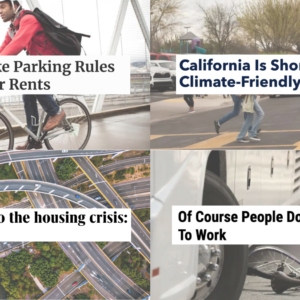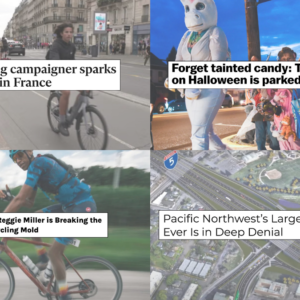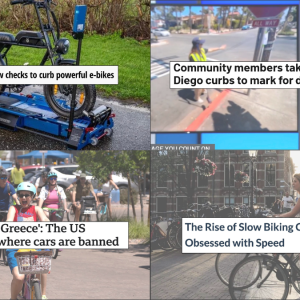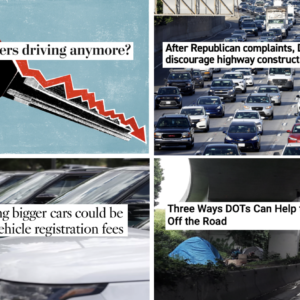Here are the bike-related links from around the world that caught our eyes this week:
When women dare to ride: “I want you, when you get married, to make riding your bikes a condition of marriage,” advises Amna Suleiman, the leader of a defiantly countercultural women’s cycling club in Gaza.
Biking jobs: 2.4 percent of the nation’s scientists bike to work, a higher rate than any other profession. Following them, at 1.5 percent: cooks and servers.
Housing costs: Seattle Transit Blog has a concise explanation of why they’ve been rising so drastically in cities that have added jobs.
Bike movie: An “unapologetic, misfit crew of young women of color” in Los Angeles that uses bikes to resist vioence is Kickstarting a documentary headed to South by Southwest.
Bike subsidies: California already subsidizes “clean” cars, so why not bikes?
“Anti-fun legislation”: The Australian state of New South Wales has approved hundreds of dollars in penalties for biking without carrying official ID or wearing a helmet.
Small corrections: The magnitude of the typical body movement is the basic difference between a skilled and novice cyclist, a new study found.
Vancouver bike share: Our Canadian sister city is getting a 1,500-smartbike system in June, before Portland’s 1,000-bike system launches.
Advertisement
Bikes vs. horses: Equestrians have successfully lobbied to ban bikes from an 80-year-old footbridge across the Los Angeles River, even if they’re being walked or carried.
Death toll: Car crashes have killed 1 million Americans since 1990, about a third more than all Americans killed by HIV.
Highway mistakes: The nonpartisan Congressional Budget Office warns that the U.S. highway system needs to immediately reallocate existing money from construction to maintenance. “The addition of new lanes is likely to have little effect on congestion within 10 years,” it said.
ODOT lawsuit: Eight people with disabilities have sued the Oregon Department of Transportation for failing to build proper sidewalk ramps when it repaves a street. ODOT doesn’t deny that it has been out of compliance.
Virtual bus: TriMet’s latest operator training equipment cost $327,000 and actually looks pretty effective.
Public interest: “City streets belong to the entire city, not just the people who live near them,” writes the New York Observer on a case of bike lane NIMBYism. “It’s the city’s role to ensure that the larger public interest is served.”
Bike lane trial: Prospect Park West’s protected bike lanes, once radical and supposedly unsightly, are heavily ridden and widely imitated, but they’re still subject to a costly civil lawsuit in court last week.
Biking actor: Ed Begley Jr., of St. Elsewhere and elsewhere, once again biked to the Oscars wearing his tux.
If you come across a noteworthy bicycle story, send it in via email, Tweet @bikeportland, or whatever else and we’ll consider adding it to next Monday’s roundup.
— Michael Andersen, (503) 333-7824 – michael@bikeportland.org
BikePortland can’t survive without paid subscribers. Please sign up today.







Thanks for reading.
BikePortland has served this community with independent community journalism since 2005. We rely on subscriptions from readers like you to survive. Your financial support is vital in keeping this valuable resource alive and well.
Please subscribe today to strengthen and expand our work.
bike subsidies – fascinating.
Similar issues have cropped up w/r/t refrigerators and other appliances. The fancy ones are eligible for rebates, but the basic models (which use less electricity in any case) are not.
I liked this closing quote: ” If we’re going to subsidize one form of low-carbon transportation, it only seems fair to look seriously at subsidizing the most low-carbon form of transportation.”
Some may quibble with whether walking has lower emissions that cycling. However, since most car trips can be easily replaced with cycling but cannot be easily replaced by walking and the subsidy’s purpose is to keep the most polluting cars off the road, I agree with the author.
Also, I’m perfectly comfortable with my bike-centric bias so I would have agreed even if I couldn’t have rationalized it. 🙂
“…However, since most car trips can be easily replaced with cycling…” b carfree
That’s a highly debatable contention. There’s no way that most people could substitute by the use of bikes for travel, travel needs they currently meet through the use of motor vehicles.
Generally though, incentives of various types granted to people able and willing to use a bike for travel rather than a motor vehicle, I think are good ideas. Community planning that supports use of bikes as a practical means of meeting people’s travel needs, could be one of the best incentives.
“There’s no way that most people could substitute by the use of bikes for travel, travel needs they currently meet through the use of motor vehicles.”
How can you say this when we haven’t bothered to try?
My guess would be that B Carfree has in mind the *statistical* fact that most car trips are not what you see in the car ads: speeding down Highway 1 alone, but short hops in town. I’d like to see some attempt to parameterize this question of substitution. I think it entirely plausible that a goodly share of the trips we now habitually use a car for could quite adequately be accomplished by bicycle. We already know that
(a) this works for households who have jettisoned the car, and
(b) that physical barriers to cycling are much less significant than lack of familiarity.
Nice thought, watts…but there seems to be very little interest or incentive to create the kinds of community designs in the U.S. or our area, that would allow most travel needs met by motor use, to be made instead with bikes.
I’d be enthusiastic about even one single neighborhood in the Portland Metro area that seriously sought to create such a community. There seems to be virtually no serious interest of substantial enough size, in that sort of thing. Biggest initial factor would seem to be that a market for it isn’t there.
Assuming there was such a market, and such a community of this type design was actually built, there still likely would be people choosing to make a bunch of their trips with motor vehicles rather than biking or walking…but at least the bike-walk specific community design would be in place to offer the potential for most trips to be made with bikes or by walking.
With over half of all car trips less than four miles, and a great many of those less than two miles, I stand by my statement that MOST car trips could be replaced with bike trips. Our society has degraded to the point that we use cars mostly as motorized wheelchairs while we all pretend we are incapable of autonomous movement.
While there certainly exists a subset of Americans who are indeed physically incapable of walking or cycling, those folks aren’t exactly the majority clogging our highways. In fact, if my acquaintances are representative, the truly disabled, as opposed to the simply lazy, mostly get around in actual wheelchairs and make extensive use of public transit.
The housing costs article is spot-on. This is why plans from Ted Wheeler and Jules Bailey to make single-family housing cheap and affordable are futile. Those “$800,000 teardown/rebuilds” they that everyone seems to rag on are a function of the pricing of land and the scarcity of housing, not the “evil” developer trying to make a quick buck of “hardworking honest families”.
We need to start building up and building denser if we don’t want to price out all but the super-rich. And not just on “corridors and town centers” like Ted Wheeler proposes, but everywhere.
Well, I think the $800,000 teardown/rebuilds replacing one single-family house with another, larger, more expensive one are actually mostly a distortion due to zoning limits on density and parking requirements.
I think they would be way less common if multiple housing units could be built on the same land instead. Especially if said multiple housing units did not each have to be accompanied by an ugly Parking Space (read: garage in most cases) at least 15′ from the sidewalk (which means each Parking Space ends up being accompanied by another space in which cars can be parked, because how else does one get from the sidewalk to the Parking Space except via a driveway?)
Agreed. The parking requirement for R5 and R2.5 is still too high. I have seen a number of lots in my neighborhood (Richmond) with one house demo’d and lot-split; turning into two or three houses. There are also quite a bit of six to twelve unit, three story buildings taking the place of one single family house on Division Street. For single-family zones, the former style of in-fill is okay, but we really need the latter type if we want to address the ongoing housing crisis. Streets like Division and 50th should be getting the large scale 100-200 unit (or more even!) development and single-family zones should be getting the 6-12 unit, three story apartment/condo buildings. Unfortunately, this is not well-reflected in the comp plan and only calls for up-zoning R5 to R2.5, when R1 is what we really need.
Regarding city streets belonging to the entire city: Someone should tell Portland. The move to essentially privatize a portion of the right of way for the exclusive storage of homeowners’ cars is a step in the opposite direction.
I was intrigued by the article in that the neighborhood association was fighting to prevent active transportation facilities that the city wanted to implement. In my neck of the woods, my neighborhood association is constantly fighting with the Eugene Public Works staff to stop making everything about our roads cars first, cars last and cars always. (My neighborhood achieved car minority status in 2010, but has since seen some reversal owing to city staff’s insistence on always making everything work perfectly for motorists no matter the consequences.)
Actually Portland homeowners have no more claim to the street in front of their house (for parking) than anyone else, which would clearly illustrate that the streets really do belong to the entire city. Even a permitted system doesn’t guarantee a parking spot, let alone one in front of your home, or even on your block.
I thought the proposed parking permit program would only allow the residents of the street to purchase them, effectively privatizing that portion of the public road.
More or less. Residents of the “parking district” which most likely will be a grouping of city blocks.
Thank you for the article on cycling in Gaza. So many things that Americans take for granted are being bravely fought for in the Arab world, especially by women. The story may not seem like much, but those women are risking their lives! That’s mind-boggling to me.
The piece on cost of housing in Seattle is based–and biased–upon the assumption that we are not allowed to address fundamental cause of inequality of wealth, but only respond to symptoms of it.
Two ideological policies of our federal government, one enforced by each of our major political parties, are the root cause of that inequality. I’ll not report what those policies are, but leave you to infer them from this:
It requires TWO HIGH INCOME EARNERS to afford the $600k rebuilds in my neighborhood.
Go figure.
If the study of novice and skilled riders involves riding rollers, one wonders if it was over before it began. I am not the indoor training type, but have always been under the impression that rollers are a related-but-distinct skill compared to the real thing.
RE: accessible sidewalks (for nonwalking humans of ALL ages, BTW), that article made me acutely aware of it on a walk the other night. They’re completely absent at many intersections in inner NE. Explain it away by saying PBOT (in this case) will get around to these during street work some day, but then there are intersections with four corners and only one ramp…
A bike subsidy that does not have incentives for transportation cycling will largely be used to purchase recreational bikes that are not used much at all. IMO, the most effective subsidy would be to extend the $255/month commuting tax credit (drivers and transit) to people cycling to work and school.
#odotknows
I knew that career change from scientist to the bike industry had some data behind it!
Hey, JM and MA, would you consider changing the first few lines of your link to the article about women cycling in Gaza? In general, my understanding is that Muslim women prefer not to be identified by their head scarves, and many regard it as objectifying (ie seeing the headscarf, not the person).
I didn’t see any mention of “head scarf power” in the piece. Also, please note that two of the four women photographed in the group shot are wearing hats, not head scarves, and their hair is showing.
I suspect that, for the two women who are wearing headscarves, it’s no more meaningful to their bicycling than their shoes, pants, shirts, and so on.
Maybe you could say “Bicycles as battleground,” as in the Times headline.
Thanks for considering this.
Hi daisy,
Thanks for sharing your feelings on this. I agree. I went ahead and edited that item to “When women dare to ride”.
Thanks! 🙂
I wish you’d pointed out what to you sounds familiar about the situation with use of Burbanks’ footbridge, currently limited to people on foot, or riding horses, compared to use of trails in Forest Park here in Portland.
Browsing the Burbank Leader story, there’s mention of a park the bridge leads to: Griffith Park. There’s no accompanying description of that park that would help give an idea of what similarities it may have with Portland’s nearly 100 year old nature park, or what numbers of people regularly ride horses in Griffith Park. Impression I’ve had of Forest Park relative to its use with horses, is that very few people ride horses there, and that they’re limited to a very small number of the park’s trails. Forest Park is an almost entirely foot travel park.
Burbank seems to be primarily concerned with use and presence of bikes, on that specific footbridge, over concern with horses being spooked by bikes on the 7′ wide bridge.The city does have bike trails in the area (as well as some trails people are prohibited from using bikes.), and are working on funding for a new bridge nearby for bike use.
I grew up on the Hollywood side of Griffith Park; there used to be a lot of trails through it used by walkers. I moved out of the area just as mountain bikes were catching on–my own riding there was on skinny tires, on pavement. It wouldn’t be surprising to hear of horse/mountain biker conflicts through there. I also am familiar with the Burbank neighborhood—the residents could easily finance a cyclist-only bridge and not cut into their Swiss numbered accounts too badly.
“Forest Park is an almost entirely foot travel park.”
Sure, if you ignore Germantown and Cornell.